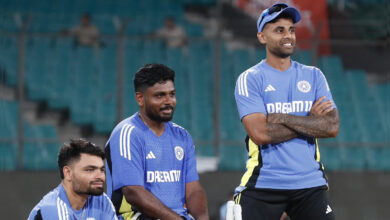Big interview: Kuldeep Yadav on art of wr spin, technical changes post-injury, Rohit Sharma as captain and bowling with MS Dhoni behind stumps | Cricket News

With 19 wickets in four matches, Kuldeep Yadav had an influential role in India winning the recently-concluded five-Test series against England. In an interview with The Indian Express, the left-arm unorthodox spinner explains his art, talks about his return to the Test side after over a year, the changes made to his technique after an injury and Rohit Sharma’s captaincy.
Devendra Pandey: At Visakhapatnam, you were playing a Test match after over a year and against an aggressive set of England batsmen. What was going on in your mind?
I was nervous. At the same time, excited too because of their (England’s) playing style. I had seen in the Hyderabad Test how they were playing reverse-sweep a lot. So, it was important to keep on length or a bit outside of it and vary the pace because if they could use pace from the bowling, it would be easy for them. Field placing was Important as well. Rohit bhai communicated well and it wasn’t a traditional field placement. I got the wicket of (Ben) Duckett in the first or second over. It gave me confidence. The more I got to play, the better I got.
Sandeep Dwivedi: When you bowl, there is a special atmosphere around the pitch – wicketkeeper advising you and both of you planning something. How important is this team spirit for someone like you who plans his wickets, and how satisfying is it when a plan works?
India’s bowler Kuldeep Yadav with captain Rohit Sharma celebrates the wicket of England’s batter Ben Stokes during the first day of the fifth Test cricket match between India and England, in Dharamshala. (PTI)
It’s very important because the wicketkeeper and short-leg fielder have an idea about what the batsman is going to do; whether he is comfortable in defence or when he is going to attack. I used to focus more on all this earlier, not that much now. You can sense yourself what the batsman is going to do. You know that after three dot balls, a batsman will step out as he doesn’t defend for long.
That wicket (Ollie Pope in the first innings of the Dharamsala Test), I had some idea that he was going to advance. But if your wicketkeeper and short-leg are involved in the game, it can be a big help.
As far as wickets are concerned, I got several important wickets. In my opinion, Zak Crawley was the best player of spin in the England team. He hardly played any sweeps or reverse-sweeps, he was playing proper cricketing shots, so it was challenging to get him out. Twice I got him out, in Ranchi and Dharamsala – and those were my best balls. He is a quality player no doubt, and sometimes you have to bowl a good ball to get a good batsman out. Those two, I feel, were the best balls. The ball that got Ben Stokes out in Ranchi, it drifted, came in and then spun away, was also good.
Sandeep Dwivedi: Jonny Bairstow had hit two sixes off R Ashwin in Dharamsala, and then you came on to bowl and got him out.
I now know how to read a batsman. When I came on, I bowled two wrong ’uns. I started with a googly. I didn’t let him get comfortable. I let him know that I would not bowl the ball spinning into him, as if I was a bowling machine. He was having a good bat-swing, so I didn’t want to make him comfortable. I bowled a ball that was the toughest for him to hit and bowled two wrong ’uns. The second-last ball was a quicker one coming in, so he would think that a googly could come too. All this is a plan to get the batsman out.
Sandeep Dwivedi: You have seen Brendon McCullum at Kolkata Knight Riders. He is an innovative coach. What is your reading of him?
I have known Baz for a long time. He keeps the players very free and is very supportive. Tactically, he makes a lot of changes on the field, as we saw in this series. When I was batting, then also I saw a lot of tactical changes in bowling and the field under Ben Stokes’ captaincy.
Also, in batting, the way Joe Root batted in the last two games, that is his style. Every player has a certain style of playing. If he plays according to that pattern, it’s better for him and also the team. But as an opposition player, you want a player like Joe Root to play in an attacking fashion so that you have a better chance to get him out because he can play a long innings.
India’s bowler Kuldeep Yadav celebrates after taking five wickets during the first day of the fifth Test cricket match between India and England, in Dharamshala, Thursday, March 7, 2024. (PTI Photo)
But I don’t have much to say about Bazball. They do a lot of things to make you uncomfortable. If you are batting, they will set a field that will make you uncomfortable so that you want to play an attacking shot. When they are batting, they will try shots like the reverse-sweep to make you uncomfortable. That was their approach.
Tushar Bhaduri: You seemed to have worked a lot on your batting. Did the team management say that you needed to do this or it was your initiative?
The team management backed me but didn’t say I had to compulsorily do it. They told me that I have a lot of batting skills, but didn’t put any pressure on me that I had to score runs. If I can contribute to the team in crucial situations, especially in Test cricket, the game changes (if the lower order scores runs). I had the ability and Vicky Paaji (batting coach Vikram Rathour) made me bat a lot (in the nets). He also kept me relaxed because when you don’t get runs, you tend to think a lot about what you have to do, saying I needed to stay calm and not take any tension, and focus on my bowling.
Nihal Koshie: At the start of your career, we had seen MS Dhoni instructing you and Yuzvendra Chahal a lot from behind the stumps. So once Dhoni retired, how was it for you?
I wanted him to play more because it was very easy for us when we were bowling. After Dhoni retired, my performance with the ball wasn’t great. It happens when a person guides you and that person’s influence is not there anymore, then suddenly everything is on your shoulders. It takes time for you to react to the situation… that probably happened to me. Then slowly you understand and become self-reliant.
But Chahal and I really enjoyed when Mahi bhai was keeping wickets, he used to give lots of ideas. I didn’t have to think too much when I was bowling. I just had to bowl and he would even adjust the fields. No doubt the time I had with Mahi bhai on the field and even off the field was great.
India’s Kuldeep Yadav with teammates celebrates the dismissal of England’s Ollie Robinson during the third day of the fourth Test cricket match between India and England, at JSCA International Cricket Stadium, in Ranchi, Sunday, Feb. 25, 2024. (PTI Photo)
Sriram Veera: What changes in your bowling action and run-up that you effected, apart from fitness, that has brought this change around?
I remember Ashish Kaushik, our physio at the NCA, telling me during the injury-rehab process: ‘Whenever you get back to proper bowling, remember to put as less of a load on the landing foot as possible before release.’ That stuck with me and also challenged me: how am I going to do that?
I then decided to try it in a local match in Kanpur later in the process. I decided to be more aggressive through the crease, rush through it so that I don’t end up loading too much pressure on that front foot. More energy through the crease.
I also cut down the angle of my approach; that has also helped in my getting more energetic. This was something Sunil Joshi (former India spinner and selector) told me as well. He had told me earlier that you can approach much straighter and with shorter strides but I hadn’t understood its significance then. There were lots of doubts too, how would the ball go from my hand. Now, all of this was playing through my mind during that rehab phase. Then on return home, when I tried that approach, I found that batsmen had less time to handle me; they were a bit rushed as the ball was going quicker through the air.
I then told my childhood coach Kapil Pandey sir who asked me a lot of questions: If I am rushing through the crease, will I be able to pivot properly on that front landing foot? Will I be able to impart more revolutions on the ball? Will the ball be quicker without turn? I told him we have a month and a half on our hands, let’s try and see and he agreed and encouraged me.
I did work a lot then; I remember my leg would swell up but I would tell, ‘Sir, don’t worry I shall apply ice’. He was with me through that journey. He is my guide, mentor, the person who pushes me and doesn’t allow me to get too relaxed.
There was a time when the left-arm wr spinner was considered too slow; here is a time when he could bowl with the pace he whims. (PTI/AP)
Sriram Veera: You seem to have a special relationship with Rohit Sharma; he cajoles you, can be strict with you and now seems to have become your batting coach at nets?
He was there at NCA when I was there rehabbing and then bowling. He had actually wanted me to incorporate some of the changes I was doing much earlier in fact. He would say when I stand at slip I feel the batsmen have enough time to play you off the pitch, that I need to get more energy through the action and that the batsman should not get time to play me. If he thinks he can get onto the backfoot to play me off the pitch, the ball should rush to hit the stumps or the pad. What he had thought in the past, I was now doing.
We have a great connection, we move around a lot together, we share personal stuff. So our bonding has been great. And the stuff he says on the field, no one minds. We have that relationship. Jo bhi voh bolte hain, humare liye pyaar hai unka (it’s his love for us). He guides and backs all the youngsters. He shows trust in others. Even If I didn’t have trust in myself, Rohit would tell me or the other person, ‘I trust you, bindaas khel’. As a batsman, he understands bowling and so that was helpful.
Now, he doesn’t tell me anything about bowling. We have reached that stage where he is focusing on my batting now, he talks a lot to me in nets and even told me after the Test series what I can work on in the break now. I feel lucky he is there.
Sriram Veera: Your coach Pandey told us your dip started after the bad experience with KKR in 2021; you weren’t getting to play. What did you learn from that phase; did it prove a motivating factor to prove a point later?
As a player you obviously want to play, contribute to the team’s wins. If you are happy, it means you are doing well in cricket. That’s confidence. That wasn’t happening then. I guess it was a learning phase.
I wasn’t perhaps accepting failure in my life. I have now become more mature, understand the game and even my personal life too. I understand that this is how the game goes, failure is part of it. So these days, I am a lot more relaxed. If something doesn’t work out, it doesn’t, you find a way out. I am more relaxed and confident about my game now, in a happy space. I now enjoy my bowling and football!







